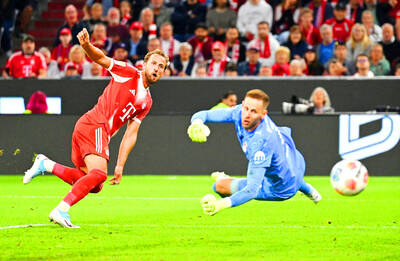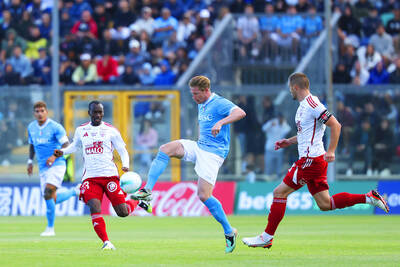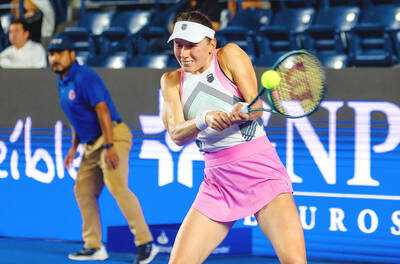These days, basketball players are prepared to jump ball and take falls.
Many NBA and college players wear thigh pads and chest pads beneath their loose-fitting uniforms, and their numbers have steadily risen. The quaint sport that James Naismith introduced to pass time in the winter has evolved into a full-contact sport requiring full-time protection.
“In the paint, basketball is very physical,” the Orlando Magic’s Dwight Howard said. “You’ve got elbows flying, bodies flying, crashing, people fighting for position. I don’t think people see all of that. That’s why a lot of people have been wearing those.”

PHOTO: NY TIMES NEWS SERVICE
He pointed to his teammate Mickael Pietrus, who was sliding into a flak jacket before a recent game.
The padding pioneer was Shaquille O’Neal, whose 216cm, 143kg frame provides ample room for bumps and bruises. O’Neal had worn girdlelike protection for a while, but five seasons ago when he joined the Miami Heat, he consulted Ron Culp, then the team’s longtime trainer, on how to best nurse a bruised rib while continuing to play.
Culp considered having O’Neal wear a bulletproof vest, but it restricted movement and weighed too much. Culp then approached Kevin O’Neill, the Miami Dolphins’ head trainer.
O’Neal maybe taller, but he weighs about the same as many football players. And after witnessing the contact O’Neal absorbed, Culp said, it was only natural to consult a football team about protection.
“Basketball is the most physical non-contact sport in the world,” Culp said. “There’s a conundrum. You’re putting 10 oversized people in an undersized place and telling them to run as fast as they can and jump as high as they can and to not get hurt while doing it.”
Dwyane Wade later started wearing the padding because he “bounces off of people like he is on a pool table,” Culp said.
O’Neal, now with Phoenix, said: “I’m a trendsetter, baby.”
LeBron James, Kobe Bryant and Amare Stoudemire are also among those who don padding.
The most dynamic players, who draw the most attention and see the most contact, are regular users.
The extra cushioning provided by padded compression shorts and a tight-fitting padded V-neck undershirt goes mostly unnoticed.
Because of O’Neal and others, McDavid, a manufacturer of protective sports equipment based in Illinois, modified its NFL gear for basketball use. Its HexPad technology involves forming foam composites into hundreds of lightweight hexagonal pads that are bonded into fabric.
The NBA is happy as long as no one sees the extra padding.
“Whether they’re wearing padded or non-padded compression gear, they can’t be visible while they’re at a standstill, and the compression tanks can’t be visible under the jersey as well,” said Stu Jackson, the league’s executive vice president for basketball operations.
But that makes it tougher to market to younger players.
“That’s the hard part of the product, that nobody sees it,” said Rey Corpuz, McDavid’s marketing director, who estimated that basketball padding for all ages could become a US$15 million to US$20 million business for his company. “It’s designed specifically not to be seen at the NBA level.”
Companies including Nike and Under Armour have also developed protective basketball padding.
“We really see this as the new modern-day uniform system,” said Todd Van Horne, a Nike creative director. “You’re not just using the jersey that’s wearing the number on the outside. The players are bigger, they’re stronger. They’re more competitive.”
So are the companies that have entered this burgeoning apparel category. McDavid is suing Nike and Adidas, citing patent infringement.
Derek Kent, a Nike spokesman, said that the lawsuit lacked factual merit and that Nike filed for its own patent nearly two years ago.
The popularity of the padded garments for basketball has been a coup for McDavid.
“If you go back into the ‘70s, guys are wearing knee pads,” Corpuz said. “Padding isn’t outside of the culture. Our biggest challenge was changing the mind-set of the average basketball player that padding was already there.”
Still, some players bristle at wearing body pads, fearing that they may restrict movement or questioning the need for them in the first place.
“Those guys who use them bang a lot,” veteran Nets guard Keyon Dooling said. “They get the ball a lot more than me. Over the years, I’ve learned how to avoid being hit by the big guys.”

Kylian Mbappe struck from the penalty spot as Real Madrid beat a dogged CA Osasuna 1-0 on Tuesday to make a winning start in Spanish La Liga under new coach Xabi Alonso. The France striker, last season’s European Golden Shoe winner, scored early in the second half, after he was fouled in the area by Osasuna defender Juan Cruz. It was enough to seal the points in Alonso’s first game in charge at the Santiago Bernabeu, with Madrid now unbeaten in their opening fixture of a league campaign since 2008. “You can see that Kylian wants to do even more

‘CATASTROPHE’: Despite losing several key forwards in the summer transfer window, Bayern were up 3-0 in the first half before Harry Kane scored a hat-trick in the second Harry Kane hit a hat-trick, Michael Olise a double and newcomer Luis Diaz also scored as Bayern Munich made a “statement” against RB Leipzig 6-0 at home in the Bundesliga season opener on Friday. Bayern’s big-money arrivals, all brought in from the Premier League across the past three seasons, were dominant as the Bavarians begun their title defense in style. Olise scored twice in the first half, either side of a Diaz strike. Not to be outdone, Kane scored three goals in the second half — with two assists coming from Diaz, to bring Bayern’s total to 6-0. Kane told the Bundesliga

Kevin de Bruyne is to lead SSC Napoli’s Serie A title defense today when he makes his full debut at promoted US Sassuolo, but the champions head into the new season rocked by a long-term injury to star striker Romelu Lukaku. De Bruyne was, alongside aging icon Luka Modric, the big new name to arrive in Italy this summer and fans were hoping his linkup with Belgium teammate Lukaku would push Napoli to success both at home and in their return to the UEFA Champions League. The 34-year-old has suffered from hamstring injuries which caused him to miss significant chunks of the

FIGHTBACK: Taiwan’s Chan Hao-ching and Jiang Xinyu of China rallied from a set down to advance to the final of the women’s doubles at the Tennis in the Land Russian second seed Ekaterina Alexandrova on Thursday beat defending champion Linda Noskova 7-6 (7/5), 4-6, 6-2 at the Monterrey Open to secure her place in the semi-finals of the US Open tune-up event. Alexandrova, 14th in the world rankings, started the decider brightly after two tightly contested sets and while Czech Noskova fought back to level at 2-2, the Russian regained control to seal the victory in just over two hours at the WTA 500 event. “I’m really glad that I could make it through, even in three sets, because it was difficult today — she served so well, she hit so